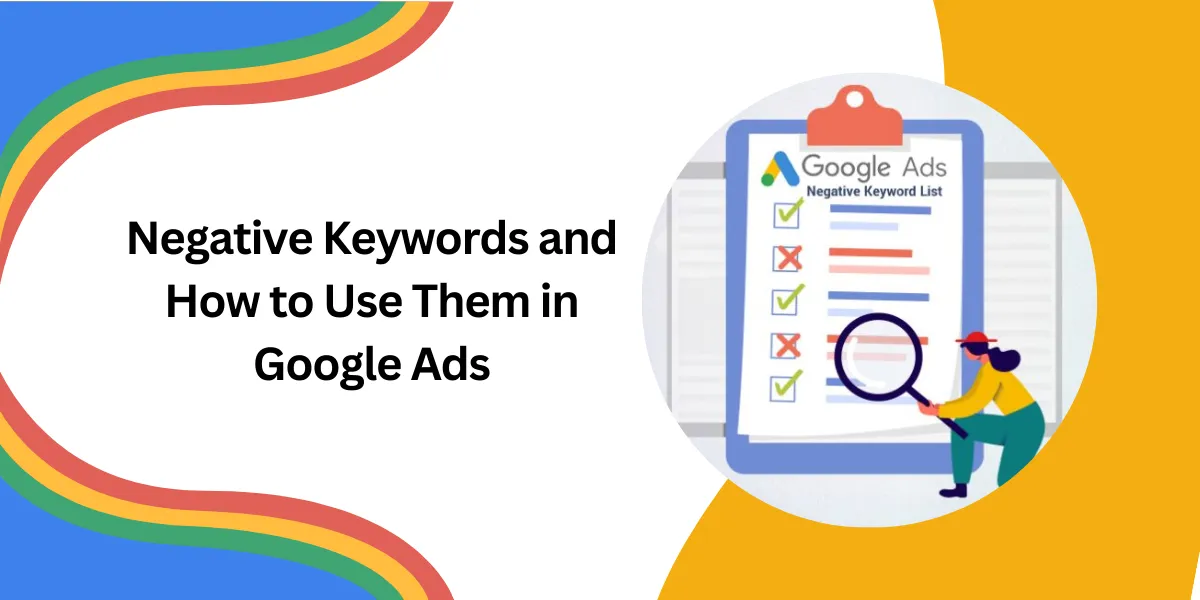What Are Negative Keywords and How Do They Work?
Negative keywords are keywords or phrases that you add to your Google Ads campaigns to prevent your ads from showing for searches that are irrelevant or unlikely to convert.
For example, if you run a flower shop, you would want to add “books” as a negative keyword so that your ads don’t show when someone searches for “books.”
When a negative keyword is triggered, your ad will not be served for that particular search query. This helps you:
- Avoid irrelevant traffic that increases your bounce rate
- Improve your Quality Score by increasing relevancy
- Reduce costs by eliminating undesirable clicks
Negative keywords only impact the campaign or ad group to which you add them. If you use the same keyword in multiple campaigns, you need to add negatives separately to each one.
Two Match Types for Negative Keywords
Phrase Match: The negative keyword phrase has to match the search query exactly for the ad to be blocked. For example, if you add “books” as a negative keyword, your ad will not show for the search “books,” but it could show for searches like “books online” or “buy books.”
Broad Match: The ad will be blocked if the search query contains a negative keyword or close variations. For example, in the “books” example, your ad would also be blocked for searches like “online books” and “order books.”
Broad match negatives give you wider coverage to prevent irrelevant searches but can sometimes block relevant queries if you aren’t careful. We’ll talk more about negative keyword strategies later in this guide.
Now that you understand the basics of how negative keywords work let’s review the different types of keywords you need to know.
Key Takeaways
- GA4 has four data retention options: 2 months, and 14 months
- The default setting is 2 months but can be changed based on business needs.
- Shorter retention periods provide less historical data but better privacy compliance.
- Longer retention allows more in-depth analysis but increases privacy obligations.
- Retention settings apply to user-level data, while aggregated data is kept indefinitely.
Types of Negative Keywords
There are three main types of negative keywords to use in Google Ads:
Competitor Brand Names
Blocking searches for your competitors is an easy way to save money on irrelevant clicks. For example, if someone searches for “Acme Products,” you don’t want your ad to show when they probably want to buy from Acme directly.
Be sure to stay on top of new competitors and add any brand names you want to avoid bidding against. Frequent monitoring of search query reports can help uncover competitor brands to add as negatives.
Industry Jargon and Unrelated Product Terms
These are keywords that are related to your broader industry but not relevant to your specific products or services.
For example, a shoe store would want to exclude foot care terms like “calluses,” bunions,” corns,” etc. An auto shop should block searches for “lawyer,” insurance,” warranty,” and other phrases not pertaining to its services.
Review your search query reports and add negatives for any industry jargon or unrelated product terms that could trigger your ads. This will reduce wasted spending and help improve your Quality Score.
General Noise Terms
You also want to block generic queries like “jobs,” prices,” coupons,” etc., that indicate the searcher isn’t ready to purchase. For local businesses, add your city name plus noise terms like “news,” “weather,” “map,” etc.
Off-topic, navigational searches are less likely to convert and negatively impact your campaign’s relevancy metrics when shown your ads. Adding noise term negatives improves your ads’ placement on more commercial queries.
Now, let’s go over some best practices for implementing and managing negative keywords.
Best Practices for Using Negative Keywords
Here are some guidelines for effectively utilizing negative keywords:
- Add negatives at the campaign and ad group levels: Use campaign negatives for queries completely unrelated to your business. Use ad group negatives for search terms relevant to the broader campaign that don’t match the specific products/services of that group.
- Leverage the Negative Keywords Lists feature: This allows you to save and apply groups of negatives across multiple campaigns. For example, you may have one list for competitor brands and another for industry jargon.
- Use a broad match to cover close variations: Broad match negatives provide wider coverage. But monitor your search query reports to ensure you aren’t blocking relevant searches due to broad matches.
- Mind keyword length: Phrase match negatives with more than one word can sometimes fail to trigger. Err on the side of adding single keywords and short phrase negatives for maximum coverage.
- Maintain a consistent negative keyword strategy. Determine best practices for structuring and managing negatives across accounts and campaigns. Document guidelines to ensure consistency even with multiple editors.
- Add negatives regularly: Check search terms reports weekly and build lists of new negatives to append. Ongoing maintenance is key, as new irrelevant queries will appear over time.
- Leverage the “Add” tool: The Add function lets you quickly apply new negatives from search queries. Click Add, check the negatives to use, and paste them into appropriate campaigns.
Proper negative keyword management will take some trial and error. But sticking to these best practices will help structure your processes for long-term success. Next, let’s go over some strategies for discovering new negative keywords to add.
How to Finding New Negative Keywords to Add
The best way to find new negative keywords is by frequently reviewing your search query reports. However, there are also some proactive strategies you can use to uncover more negatives:
- Search query mining: Download your search queries and rank them by impression volume. Identify irrelevant queries with high impressions that should be added as negatives.
- Check Auction Insights: Look for high impression queries where you are not ranking well and add these as negatives.
- Review competitors’ ads: Search for your high-volume keywords and note that irrelevant ads are showing. Add the advertisers’ domains as negatives.
- Analyze landing page content: Identify words/phrases in your ad and landing page copy that are unrelated to your offer and add those as negatives.
- Leverage tools: Keyword research tools like Google Trends, Übersuggest, and KeywordTool.io can generate negative keyword ideas based on your seed keywords.
- Brainstorm variations: Think of other forms, synonyms, typos, etc., for common negative terms. For example, “shoes” could also be “footwear,” “sneakers,” “shoes,” etc.
What are Some Common Negative Keyword Mistakes You Should Avoid It
It’s easy to accidentally implement negative keywords in a way that limits your campaign’s capabilities. Here are some errors to watch out for:
- Using overly broad negatives: Broad match negatives sometimes block relevant queries. Review the search term reports to catch any mistakes.
- Not adding negatives below the ad group level: Adding negatives at the keyword or ad level increases match coverage. Don’t only use campaign and ad group negatives.
- Not monitoring effect regularly: Check search query reports weekly to confirm new irrelevant searches are being blocked.
- Restricting negatives to obvious unrelated terms: Also include industry jargon, navigational terms, and common misspellings, not just clearly unrelated keywords.
- Not considering localization: Add negatives containing local dialect, abbreviations, airport codes, etc., to prevent irrelevant local clicks.
- Forgetting negatives when updating campaigns: When you refresh keywords or ad copy, also re-check that negatives are still required.
- Using a match type that is too rigid, leverage both broad and phrase match negatives for maximum coverage. Don’t rely only on one match type.
- Not coordinating across accounts: If running multiple accounts, ensure your negative keywords strategy is consistent. Maintain a shared library of universal negatives.
With some discipline, you can avoid these common traps and implement negatives effectively. Next, let’s look at best practices for using negatives in search vs. display campaigns.
Negative Keywords for Search vs. Display Campaigns
Negative keywords are important for both search and display network campaigns. However, the best practices differ:
Search Campaigns
- Use negatives to weed out commercial intent queries that aren’t relevant
- Block comparisons between your brand and competitors
- Add typos and misspellings related to your products
Display Campaigns
- Use negatives around offensive, sensitive, or inappropriate topics
- Block websites/placements where your ads would be irrelevant
- Exclude categories unrelated to your target audience
The major difference is search negatives focus on intent, while display negatives prevent irrelevant placements.
For search, concentrate on queries that show intent to purchase your type of product but are different from what you offer. Display negatives revolve more around topics and audiences.
Evaluate search queries and placement performance often. Identify irrelevant searches and websites/apps to expand your negative keywords continuously.
What are the Importance of Ongoing Negative Keyword Management
Proper negative keyword management requires an ongoing, consistent effort. You need to remember them before you can set negatives once.
As your campaigns evolve and new queries appear, you need to continually:
- Review search query and placement reports weekly
- Mine for new high-impression irrelevant terms
- Stay on top of new competitor brands and products
- Monitor changes in language and searcher intent
- Keep abreast of category trends on the display network
- Update lists at least monthly with new negatives
Treat negative keywords as an integral part of campaign optimization, not a one-time task. Allocate time regularly to analyze data and expand your negatives.
Prioritize identifying and blocking queries/placements that generate high impressions but haven’t converted. Stop spending on these irrelevant searches as soon as possible.
Stay vigilant to avoid a situation where the majority of your budget goes towards untargeted, irrelevant traffic. Consistent negative keyword management ensures your ads show for profitable searches.
Final Thoughts
Negative keywords are a vital part of any Google Ads account strategy. Properly managing negatives prevents wasted ad spending on irrelevant queries and placements. This allows you to maximize the performance of your budgets and drive more high-quality traffic.
By leveraging the right match types, continuously adding new negatives, and keeping up with regular maintenance, you can achieve significant improvements. Don’t leave negatives as an afterthought. Make ongoing negative keyword management a top priority, and you will see your campaigns reach their full potential.
Apply the tips and best practices outlined in this guide to build effective negative keyword strategies. With the right approach, you can tap into the power of negatives to boost campaign ROI and unlock the full value of your Google Ads investment.
Frequently Asked Questions
How many negative keywords should I be using?
There is no ideal or recommended number of negatives. The right amount depends on factors like your industry, competitors, location, and campaign targets. Add as many high-impression negatives as needed to block irrelevant searches. Most accounts need at least a few hundred negatives.
Should I use negative keywords for brand campaigns?
Yes, brand campaigns still benefit from negatives—block searches with misspellings of your brand name. Also, negatives for competing brands and unrelated industry terms should be added.
Can you add negatives to maximize Google Ads’ automated bidding strategies?
Yes, adding negatives helps automated bidding work better by filtering out irrelevant searches. Just ensure your negative keywords strategy aligns with the optimal conversions or conversion value you want those bids to drive.
When is the best time to add negative keywords?
Add high-impression, high-cost negatives as soon as possible. Otherwise, set aside time at least monthly to mine search queries and add any new irrelevant ones being triggered. Get in the habit of ongoing negative keyword management.
Should I use negative keywords in phrases or exact-match campaigns?
Yes, negatives still provide value in phrase and exact match campaigns. Someone may search for an exact phrase that contains your keyword but is irrelevant. Negative keywords give you added protection.



